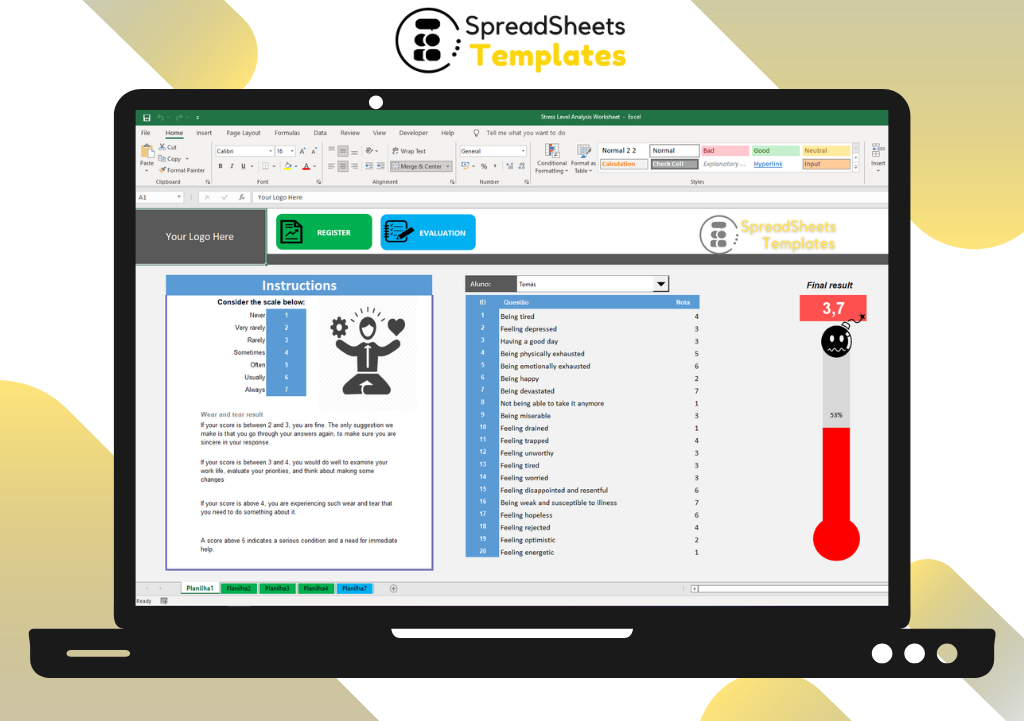Stress Level Analysis Worksheet Leave a comment
A Comprehensive Guide to Managing Stress
Introduction
In today’s fast-paced world, stress has become an inevitable part of our lives. Whether it’s work-related pressures, personal challenges, or the constant bombardment of information, stress can take a toll on our physical and mental well-being. To effectively manage stress, it is essential to understand its underlying causes and devise strategies to mitigate its impact. This is where a Stress Level Analysis Worksheet comes into play. In this comprehensive guide, we will explore the importance of stress analysis, how to use a stress level analysis worksheet effectively, and provide you with practical tips to reduce stress in your life.
Table of Contents
- What is Stress?
- Definition of Stress
- Types of Stress
- Understanding Stress Level Analysis
- Importance of Stress Level Analysis
- Benefits of Using a Stress Level Analysis Worksheet
- How to Use a Stress Level Analysis Worksheet?
- Step 1: Download or Create a Stress Level Analysis Worksheet
- Step 2: Identify Stressors
- Step 3: Rate Stress Levels
- Step 4: Analyze Patterns and Triggers
- Step 5: Develop Coping Strategies
- The Impact of Stress on Health
- Physical Health
- Mental Health
- Emotional Well-being
- Tips for Reducing Stress
- Practice Mindfulness and Meditation
- Engage in Regular Exercise
- Maintain a Balanced Diet
- Get Sufficient Sleep
- Prioritize Self-Care
- Seek Support from Others
- Incorporate Relaxation Techniques
- Manage Time Effectively
- Set Realistic Goals
- Avoid Overcommitting
- Limit Exposure to Stressful Situations
- Practice Assertiveness
- Foster Healthy Relationships
- Take Breaks and Vacations
- Engage in Hobbies and Leisure Activities
- Stress Level Analysis Worksheet: FAQs
- What is a stress level analysis worksheet?
- How can a stress level analysis worksheet help me?
- Can I create my own stress level analysis worksheet?
- Is a stress level analysis worksheet suitable for everyone?
- Are there any online resources for stress level analysis worksheets?
- How often should I use a stress level analysis worksheet?
- Conclusion
What is Stress?
Definition of Stress
Stress can be defined as the body’s response to external or internal demands, often referred to as stressors, that disrupt its normal state of equilibrium. It triggers a series of physiological and psychological changes in an individual, preparing them to face challenges or threats. While a certain level of stress can be beneficial for motivation and performance, excessive and prolonged stress can have detrimental effects on health and well-being.
Types of Stress
There are various types of stress that individuals may experience. Some common types include:
- Acute Stress: This type of stress is short-term and is often triggered by immediate pressures or demands. It can occur in response to an upcoming deadline, an important presentation, or a sudden life event.
- Chronic Stress: Chronic stress is long-term and typically arises from ongoing or persistent stressors, such as work-related issues, financial difficulties, or relationship problems. It can have a cumulative effect on health if not effectively managed.
- Episodic Acute Stress: Episodic acute stress is characterized by repeated episodes of acute stress. Individuals who frequently experience high levels of stress tend to exhibit this pattern. It can lead to a state of constant tension and anxiety.
- Traumatic Stress: Traumatic stress occurs in response to a traumatic event or experience, such as natural disasters, accidents, or witnessing violence. It can have a profound impact on an individual’s mental and emotional well-being.
Understanding the different types of stress can help individuals identify their stressors and develop appropriate strategies to manage them effectively.
Understanding Stress Level Analysis
Importance of Stress Level Analysis
Stress level analysis plays a crucial role in recognizing the factors that contribute to stress and evaluating its impact on our lives. By conducting a stress level analysis, individuals gain insight into their stressors, triggers, and patterns, enabling them to make informed decisions about stress management techniques. It empowers individuals to take control of their well-being and make proactive changes to reduce stress.
Benefits of Using a Stress Level Analysis Worksheet
Using a stress level analysis worksheet offers several benefits, including:
- Self-Awareness: A stress level analysis worksheet helps individuals develop self-awareness by identifying the specific stressors they face and the impact those stressors have on their well-being.
- Identification of Patterns: By tracking stress levels over time, patterns and triggers can be identified. This knowledge enables individuals to recognize recurring stressors and take necessary measures to mitigate their effects.
- Effective Stress Management: A stress level analysis worksheet allows individuals to develop personalized stress management strategies based on their unique stressors and triggers. It facilitates the selection of techniques that work best for them.
- Goal Setting: The worksheet assists individuals in setting realistic goals for stress reduction. By regularly monitoring stress levels, progress can be tracked and adjustments made to achieve desired outcomes.
- Progress Evaluation: Using a stress level analysis worksheet allows individuals to assess the effectiveness of their stress management techniques. It provides a tangible record of progress and helps identify areas that require further attention.
By utilizing a stress level analysis worksheet, individuals can gain valuable insights into their stress levels, enabling them to take proactive steps towards reducing stress and enhancing overall well-being.
How to Use a Stress Level Analysis Worksheet?
Using a stress level analysis worksheet is a straightforward process that involves a series of steps. Follow the steps below to effectively utilize a stress level analysis worksheet:
Step 1: Download or Create a Stress Level Analysis Worksheet
You can find various stress level analysis worksheets online or create your own using a spreadsheet program or pen and paper. Choose a format that suits your preferences and provides enough space to record relevant information.
Step 2: Identify Stressors
Identify the stressors in your life. These can be related to work, relationships, finances, health, or any other aspect that contributes to your stress levels. Make a list of these stressors in the worksheet.
Step 3: Rate Stress Levels
Assign a rating to each stressor based on its perceived impact on your well-being. You can use a scale of 1 to 10, with 1 indicating minimal stress and 10 representing extreme stress. Record these ratings in the worksheet.
Step 4: Analyze Patterns and Triggers
Regularly review the recorded stress levels and look for patterns and triggers. Are there specific situations, events, or circumstances that consistently result in higher stress levels? Identify these patterns to gain a deeper understanding of your stressors.
Step 5: Develop Coping Strategies
Based on your stress level analysis, devise coping strategies to manage stress effectively. This can include techniques such as deep breathing exercises, journaling, seeking support from loved ones, engaging in hobbies, or practicing mindfulness. Tailor the strategies to address your specific stressors.
By diligently following these steps and utilizing a stress level analysis worksheet, you can gain valuable insights into your stress levels and develop a personalized approach to stress management.
The Impact of Stress on Health
Stress can have a profound impact on both physical and mental health. Understanding these effects is crucial for individuals seeking to manage stress effectively. Let’s explore how stress can affect different aspects of our well-being:
Physical Health
Prolonged or chronic stress can lead to various physical health issues, including:
- Cardiovascular Problems: High levels of stress can contribute to increased blood pressure, heart disease, and an increased risk of heart attacks.
- Weakened Immune System: Chronic stress can weaken the immune system, making individuals more susceptible to infections and illnesses.
- Digestive Disorders: Stress can disrupt the digestive system, leading to issues such as stomachaches, indigestion, and irritable bowel syndrome (IBS).
- Muscle Tension and Pain: Stress often manifests as muscle tension, which can result in headaches, backaches, and general body pain.
- Sleep Disturbances: Stress can interfere with sleep patterns, leading to insomnia or restless nights, further exacerbating fatigue and exhaustion.
Mental Health
Stress can significantly impact mental well-being, contributing to the development or worsening of various mental health conditions:
- Anxiety Disorders: Chronic stress can trigger or intensify anxiety disorders, such as generalized anxiety disorder (GAD), panic disorder, or social anxiety disorder.
- Depression: Prolonged stress can increase the risk of developing depression or exacerbate existing depressive symptoms.
- Cognitive Impairment: Stress can impair cognitive function, affecting memory, concentration, and decision-making abilities.
- Mood Swings: Stress can cause frequent mood swings, leading to irritability, frustration, and difficulty regulating emotions.
Emotional Well-being
Stress can impact emotional well-being, leading to:
- Feelings of Overwhelm: Excessive stress can make individuals feel overwhelmed, emotionally drained, or unable to cope with everyday challenges.
- Low Self-Esteem: Chronic stress can contribute to diminished self-esteem and self-worth, undermining confidence and self-belief.
- Relationship Strain: Stress can strain personal and professional relationships, leading to conflict, communication breakdowns, and a lack of emotional support.
It is vital to recognize the impact of stress on health and take proactive steps to manage stress effectively, promoting overall well-being.
Tips for Reducing Stress
Effectively managing stress is essential for maintaining a healthy and balanced life. Here are some practical tips to reduce stress:
- Practice Mindfulness and Meditation: Engaging in mindfulness exercises and meditation can help calm the mind and reduce stress levels. Set aside dedicated time each day for these practices.
- Engage in Regular Exercise: Physical activity releases endorphins, which are natural mood enhancers. Engage in regular exercise, such as walking, jogging, or yoga, to reduce stress and improve overall well-being.
- Maintain a Balanced Diet: Proper nutrition plays a crucial role in managing stress. Ensure your diet includes a variety of fruits, vegetables, whole grains, lean proteins, and healthy fats.
- Get Sufficient Sleep: Prioritize quality sleep by establishing a bedtime routine and creating a sleep-friendly environment. Aim for 7-9 hours of sleep each night to support stress reduction.
- Prioritize Self-Care: Set aside time for self-care activities that bring you joy and relaxation. This can include reading, taking baths, practicing hobbies, or indulging in activities that recharge your energy.
- Seek Support from Others: Reach out to friends, family, or support groups to share your feelings and experiences. Talking to others can provide emotional support and perspective.
- Incorporate Relaxation Techniques: Explore relaxation techniques such as deep breathing exercises, progressive muscle relaxation, or guided imagery to alleviate stress and induce relaxation.
- Manage Time Effectively: Develop effective time management skills to avoid feeling overwhelmed. Prioritize tasks, delegate when possible, and set realistic goals to minimize stress related to time pressures.
- Set Realistic Goals: Establish achievable goals and break them down into manageable steps. Celebrate small victories along the way, reinforcing a sense of accomplishment and reducing stress.
- Avoid Overcommitting: Learn to say “no” when necessary and avoid taking on more than you can handle. Overcommitting can lead to increased stress levels and a sense of being overwhelmed
Incorporating these strategies into your daily routine can significantly reduce stress and improve your overall quality of life.
FAQs
1. What is a stress level analysis worksheet?
Is a tool used to assess and track an individual’s stress levels. It involves identifying stressors, rating stress levels, and analyzing patterns to gain insights into stress triggers and their impact.
2. How can a stress level analysis worksheet help me?
Helps you gain awareness of your stressors and their effects on your well-being. It allows you to develop personalized strategies to manage stress effectively and make positive changes in your life.
3. Can I create my own stress level analysis worksheet?
Yes, you can create your own stress level analysis worksheet using a spreadsheet program or pen and paper. Customize it according to your preferences and ensure it includes sections for stressor identification, stress rating, and analysis.
4. Is a stress level analysis worksheet suitable for everyone?
Yes, a stress level analysis worksheet can be beneficial for anyone seeking to manage stress effectively. It can be adapted to individual needs and circumstances, making it suitable for a wide range of individuals.
5. Are there any online resources for stress level analysis worksheets?
Yes, there are various online resources where you can find pre-designed stress level analysis worksheets.
6. How often should I use a stress level analysis worksheet?
The frequency of using a stress level analysis worksheets depends on your personal preference and needs.
Conclusion
Managing stress is essential for maintaining a healthy and balanced life. By utilizing a stress level analysis worksheet and implementing effective stress management strategies, individuals can gain control over their stress levels and enhance their overall well-being. Take the time to assess your stressors, develop coping mechanisms, and prioritize self-care. Remember, reducing stress is a journey, and small steps can lead to significant improvements in your quality of life.


